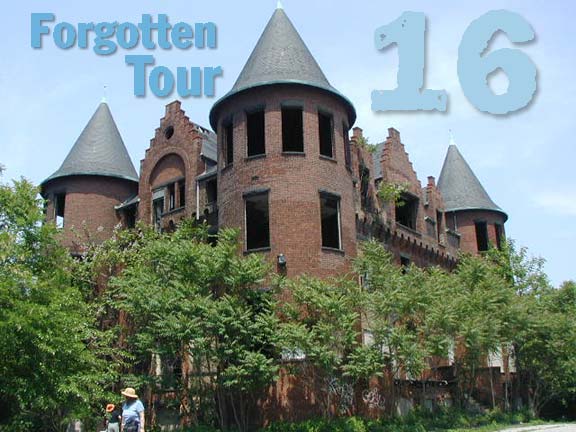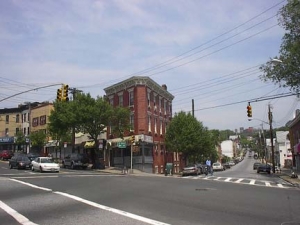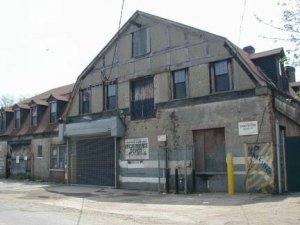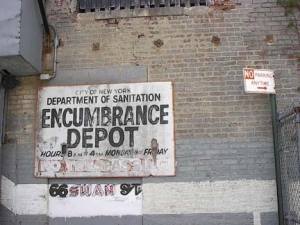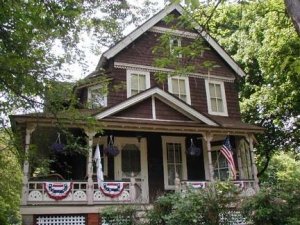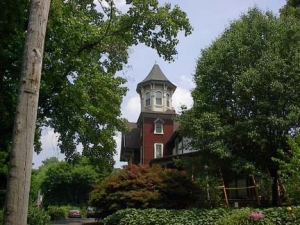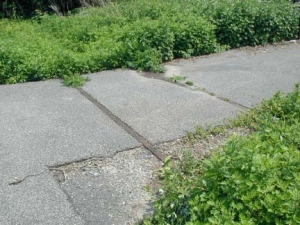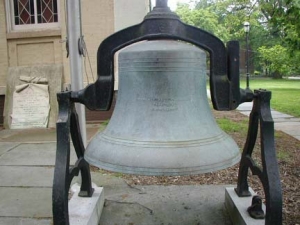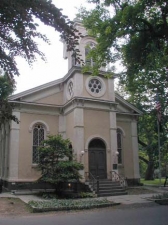S.R. Smith Infirmary, New Brighton, Staten Island
HEY, you missed a good one. Twenty Forgotten fans…a lower total than most recent tours…visited Tompkinsville and New Brighton, two of Staten Island’s more venerable small towns, seeing its collection of Victorian-era “gingerbread” mansions, unusual architecture, abandoned relics, and ending at Snug Harbor, originated by Robert R. Randall in the 1801 as a home for “aged, decrepit and worn-out sailors” which is today being converted into a museum and cultural center. In fact the tour was so good…there are THREE Forgotten NY pages written from it! Read on below…
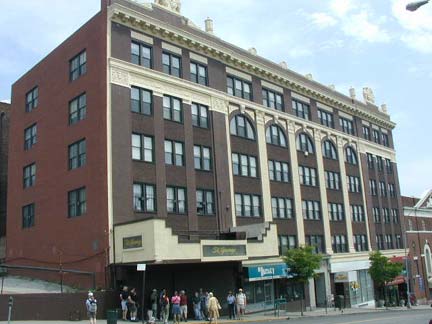
After gathering at the South Ferry subway stop Forgottoners rode the ferry to St. George Terminal, Staten Island. Both ends of the ferry in Manhattan and Staten Island are undergoing multimillion-dollar restorations.
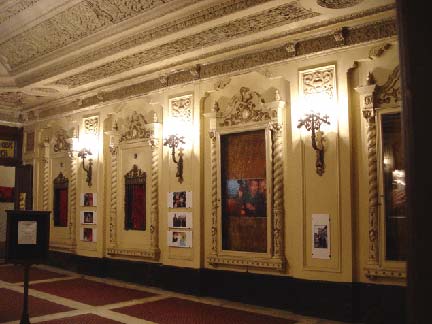
Entrance foyer
A quick walk up Hyatt Street leads to the magnificent St. George Theatre. The 2800+ seat theatre, opened in 1929, has been mostly dormant since the early 1980s, but unlike its ornate compatriots in the Bronx, Brooklyn and Queens it hasn’t fallen completely into ruin, and for some years, its interior has been given TLC by a dedicated band of volunteer workers. Not to say it doesn’t need a few million for a complete restoration, but if that kind of funding can be found, it could become a crown jewel cultural space in St. George, for stage shows and maybe even movies again. Already the theatre is home to the Richmond Dance Ensemble; comic Jack Black and his young charges played a (simulated) rock concert here in 2003’s School of Rock; in the late 70s, Meat Loaf played here on the back ofBat Out of Hell.
![]() Interior of the St George Theatre…don’t miss this!
Interior of the St George Theatre…don’t miss this!

photo: Nigey Lennon
Brooklyn might have been the former “City of Churches” but Staten Island is the borough of small towns. Richmond County was once comprised of four towns (Northfield, Southfield, Westfield and Castleton, dotted with villages like Tompkinsville, New Brighton and St. George). A walk in Tompkinsville still feels like a walk in a midwestern village, with a well-defined main street (Victory Blvd., renamed in 1918 after its original incarnation as Richmond Turnpike) and side streets full of all manner of eclectic architecture.
Corner of Victory Blvd, and Montgomery Ave (top left); fancifully-painted structure on the opposite corner, and terra cotta-enhanced brick building on Montgomery. Photos above and below left: Eric Weaver
Photos of small-town America often feature a Rexall drugstore smack in the middle of things, and Tompkinsville has one of its very own, at Victory Blvd and St. Marks Place.
As we pressed south into Stapleton, Forgottoners spied an unusual structure on Swan Street and rushed to investigate. Well, not rushed…it was 88 degrees.
Chatting with neighbors bore out the susupicion that it had been, at one time, a barn, complete with hoist below the roof. Some time in the past the Department of Sanitation took it over as an “encumbrance depot.”
(The last time I came across the word “encumber” was in the Hollies’Boys Town-inspired smash, “He Ain’t Heavy, He’s My Brother.”)
Photos above and below left: Eric Weaver
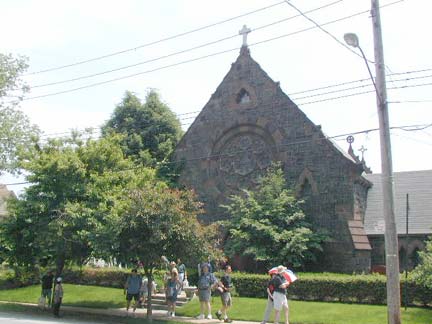
The Victorian Gothic St. Paul’s Church. The Episcopal parish has been in the area since 1833; this is the second church building, designed ny architect Edwin Potter, and consecrated by his uncle Bishop Horatio Potter..all in the family. Stapleton is dotted with many chuches, many older than this one.

387 St. Pauls Avenue, possibly the most gorgeous private dwelling in Staten Island and a contender for most beautiful building in NYC. It is one of the many “painted lady” Victorians in the area. I’m told that these buildings used a limited pallette of colors (for example, none were painted white). I’ve been past this building before, and it used to be a more garish orange color; it’s been tastefully muted since in pale yellow and ecru.

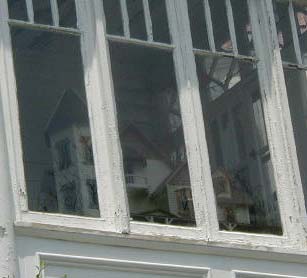
A close look inside one of the windows at this magnificent corner mansion at Occident and Marion reveals… a scale model of itself! Not an exact scale model, but a valiant effort. Bunting was evident on many of the mansions, a trend I hadn’t spotted previously. Memorial Day would be the following weekend.
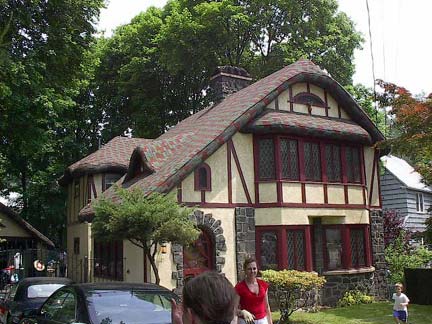
The magnificent building on Cebra Avenue west of Ward is just the last remnant of a much larger estate. It was originally the gatehouse and was beautifully Tudor-ified by James Pietsch in 1927.
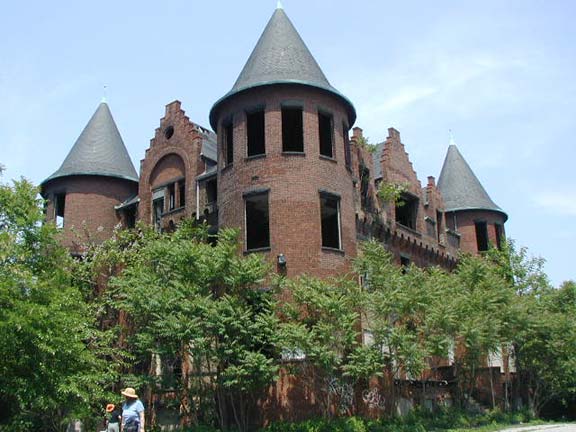
Forgottoners pause at the Samuel R. Smith Infirmary (aka. The Frost Building), built on Castleton Avenue in 1889 (the same year the Victorian at 387 St. Pauls Avenue, above, was constructed…a good year for architecture!) It has housed Staten Island Hospital and a training school for nurses during its long history. Herman Melville‘s sister-in-law (her husband was director of Snug Harbor (see below) in the 1890s was a secretary here. The hospital moved out in 1979.

Photo: Colin Vozeh
This building has never been landmarked and has been left to the ravages of the elements, and unscrupulous developers, for 25 years. The interior is pretty much gutted, and we hear that the Infirmary is slated for demolition later in 2004.
![]() Forgottentour photos of the Infirmary interior…don’t miss!
Forgottentour photos of the Infirmary interior…don’t miss!
After leaving the Infirmary we went up Lafayette Avenue to view more of New Brighton’s magnificent Victorian buildings.
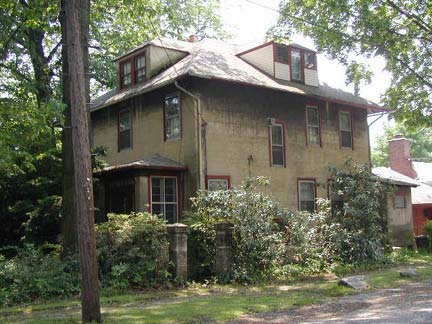
This building on Arnold Street and Lafayette Avenue with itsFrank Lloyd Wright-ian features (though not a Wright) is one of the first buildings in NYC made of concrete (built around 1900).
Wright did design one private residence in Staten Island, one of his final works, Crimson Beech, found in Lighthouse Hill near Richmondtown.
William S. Pendleton, an engraver, lithographer, realtor and owner of a ferryboat company, owned both 22 Pendleton Place (a Gothic Revival villa, 1855) and 1 Pendleton Place (a larger “Stick Style” mansion across the street, 1861). Both are best seen in winter when the leaves are down. In 2004 1 Pendleton was being renovated. Each was built by British architect Charles Duggin. Photo right: Eric Weaver
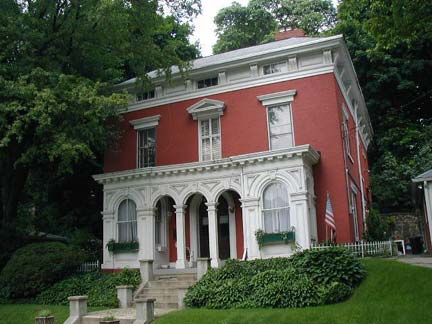
The Hamilton Park Cottage (‘cottage’ is a relative term) at 105 Franklin Ave, a bit north of the Pendleton houses, is a landmarked building constructed by Carl Pfeiffer in 1864.

We got here a couple of months too late to view the 1871 New Brighton Town Hall at Lafayette Avenue & Fillmore Street, which was demolished in February 2004. The building had been landmarked as far back as 1965 and was 3 stories high and had red bricks, a mansard roof, dormers and arched roofs. After NYC Consolidation in 1898, the Village Hall was a court house, a military draft center and a medical center, but after 1968 it fell into private hands; it was allowed to deteriorate and rot, apparently past saving.

Staten Island Rapid Transit North Shore line map by Michael Calcagno. Map from nycsubway.org
The operation of the original Staten Island Railroad was from Cranford Junction, NJ to St. George, Staten Island via the North Shore line, and then on to Tottenville or South Beach (via a cutoff at Bay Street and Greenfield Avenue). The passenger operation on the North Shore (Arlington–St. George) and South Beach line (St. George–Wentworth Ave) was eliminated in 1953. All of the bridges over the North Shore line remain, and were recently rebuilt by NYC DOT.
Snug Harbor, an 83-acre National Historic Landmarked District, was founded in the Washington Square area of Manhattan by Robert Richard Randall when he specified that his fortune be left to the care of retired seamen without other means of support. Randall was the bachelor son of a privateer and knew well the toll a life at sea can take on the body and psyche. After Randall’s death in 1801, over twenty years was spent in adjudicating claims to Randall’s fortune, and by 1821, lower Manhattan had grown considerably and land for the sort of retreat Randall had had in mind was unavailable. Snug Harbor trustees purchased Isaac Housman’s farm in then-rural Richmond County in the 1830s. Architect Minard Lefever was commissioned to build Snug Harbor’s nagnificent Greek Revival edifices, only some of which remain today. At its peak Snug Harbor was home to over 1000 seamen; by 1976 operations had relocated to North Carolina. The buildings were allowed to deteriorate for awhile, and some were demolished, but seven have been landmarked and Snug Harbor is in the process of becoming a premier cultural center in NYC. It includes the adjacent Staten Island Botanical Garden (while the Bronx, Queens and Staten Island have Botanical Gardens, Brooklyn has to be different: it has a Botanic Garden) and Children’s Museum.
What is likely part of the Snug Harbor passenger station remains here on Richmond Terrace just west of Tysen Street. Some of the tracks can still be found in the weeds. West of here, much of the North Shore Branch remains more or less intact. There are still discussions about using the line for freight; freight service from Cranford Junction and Arlington Yard is about to be restored with the finished repairs to the Arthur Kill railroad bridge.
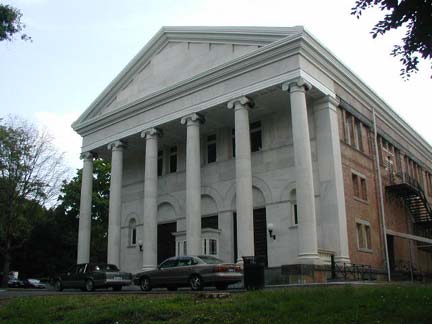
Above is the 1892 Music Hall, the second oldest concert hall in NYC (only Carnegie Hall is older, by one year). I wonder what the old seamen would have thought of David Bowie, as the Thin White Duke appeared here as part of a 5-night, 5-borough concert tour here in October 2002.

Faded sign on the Music Hall
Veterans Memorial Hall was built in 1856 as a seaman’s chapel. The ball tower was added in the 1880s, as you can see, the bell has been placed outside the chapel. The tribute to Randall is original to the chapel.

